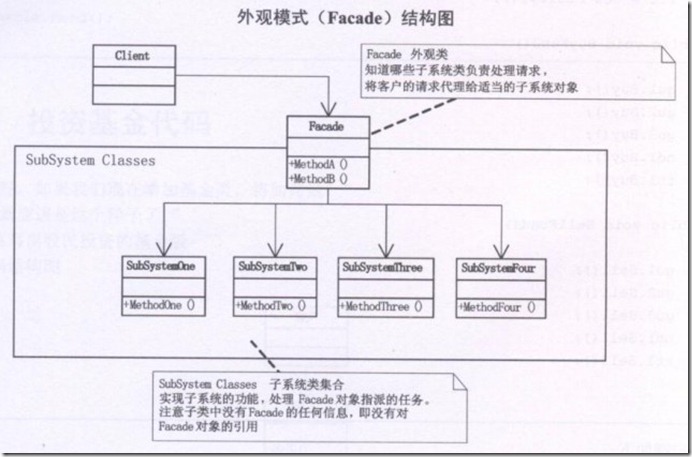重点概念回顾
1.为子系统中的一组接口提供一个一致的界面,此模式定义了一个高层接口,这个接口使得这一个子系统更觉容易使用。
2. 即使不知道外观模式也一定使用过外观模式,他完美的体现了依赖倒置(面向接口编程)原则和迪米特法则(功能松耦合)的思想,十分常用。
3. 外观模式的核心是,通过将分散的功能包含在外观类中,从而提供一致的操作接口,封装实现,起到了松耦合的目的
4. 在设计的初期阶段,应该要有意识的建立层次上的分离。
5. 可以为封装复杂的接口,也可以为封装众多功能的接口,使用外观模式。
6. 外观模式就是封装复杂。
演示例题
using System; using System.Collections.Generic; using System.Text; namespace 外观模式 { class Program { static void Main(string[] args) { Facade facade = new Facade(); facade.MethodA(); facade.MethodB(); Console.Read(); } } class SubSystemOne { public void MethodOne() { Console.WriteLine(" 子系统方法一"); } } class SubSystemTwo { public void MethodTwo() { Console.WriteLine(" 子系统方法二"); } } class SubSystemThree { public void MethodThree() { Console.WriteLine(" 子系统方法三"); } } class SubSystemFour { public void MethodFour() { Console.WriteLine(" 子系统方法四"); } } class Facade { SubSystemOne one; SubSystemTwo two; SubSystemThree three; SubSystemFour four; public Facade() { one = new SubSystemOne(); two = new SubSystemTwo(); three = new SubSystemThree(); four = new SubSystemFour(); } public void MethodA() { Console.WriteLine("\n方法组A() ---- "); one.MethodOne(); two.MethodTwo(); four.MethodFour(); } public void MethodB() { Console.WriteLine("\n方法组B() ---- "); two.MethodTwo(); three.MethodThree(); } } }
冯瑞涛





 浙公网安备 33010602011771号
浙公网安备 33010602011771号